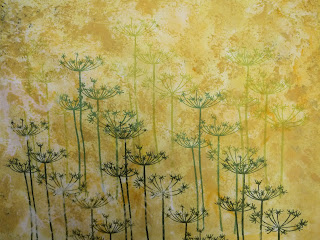The Contemporary Quilt Group, of which I am a member, has an exhibition at Festival of Quilts this year and I was one of the sixty-plus members who entered a quilt. Unfortunately I was one of the ones whose work didn't get chosen. I did discover however that I am in excellent company: people who have produced much better pieces than I did also didn't get their work chosen. I suspect the standard of the exhibition will be extremely high.

The theme of the exhibition was Tin and the starting-point was a photograph by Tony Howell of East Pool Tin Mine, a restored tin mine in Cornwall. A comment by an historian friend about Cornish miners who had migrated to the north of England being known as "Cousin Jacks" led me into spending some time doing historical research of my own, and being deeply moved by the way in which the closure of the mines in Cornwall in the nineteenth century led to mass migration and emigration from the county - a quarter of a million men, mainly miners, emigrated between 1841 and 1901; whole villages could disappear from the census in a ten-year period; there was a twenty percent reduction in the male population in each ten-year period between those years. At the beginning of the twentieth century the total population - male and female, including children - was less than half a million. "Cousin Jacks" took their skills to the far corners of the world - including North and South America, Australia, New Zealand and South Africa. There's a saying: "A mine is a hole in the ground, anywhere in the world, with at least one Cornishman at the bottom of it", and to this day people all over the world celebrate their Cornish ancestry.
I suppose one of the reasons for my response is that I come, a couple of generations back, from a mining family myself. Not Cornwall, but South Wales, and there and in parts of Yorkshire I have seen the effects of pit closures on local communities - not as devastating or dramatic as in nineteenth century Cornwall, but still a sense of the lifeblood draining out of the community when the mines close.
This became the basis of the quilt above. Unfortunately, though there is a thematic link to the original photograph, the visual links to it have mostly disappeared - it seemed appropriate to use a ruined mine rather than a restored mine as the main image and the only bit of the photograph I've actually been able to use is the texture of the stone. So yes
I would acknowledge that it may not have fulfilled the criterion of having a specific (i.e. visual) reference to the original image. The jurors also felt that there were some pieces where an interest in the history had taken over rather than the consideration of the visual impact of the piece, and I accept this criticism too.
My personal feelings about this piece is that there are things in it that I like but also things that are unresolved. I think I distracted myself with two things: firstly the attempt to convey a message visually, which is a very difficult thing to do and which I don't think worked out effectively (I have a tendency to believe that a piece of work should be able to communicate independently of artists statements or footnotes) and secondly the decision to include a "picture", however simplified.
It has not been wasted: I learnt a great deal from doing it. And I do like the lettering (dyed fabric hand-painted with discharge paste), the story of the "Cousin Jacks" half hidden behind the image, and covered with layers of silk organza.
Only problem is - what do I do with it now? It is a somewhat bleak image, not one that fits easily on the walls of my home!




































